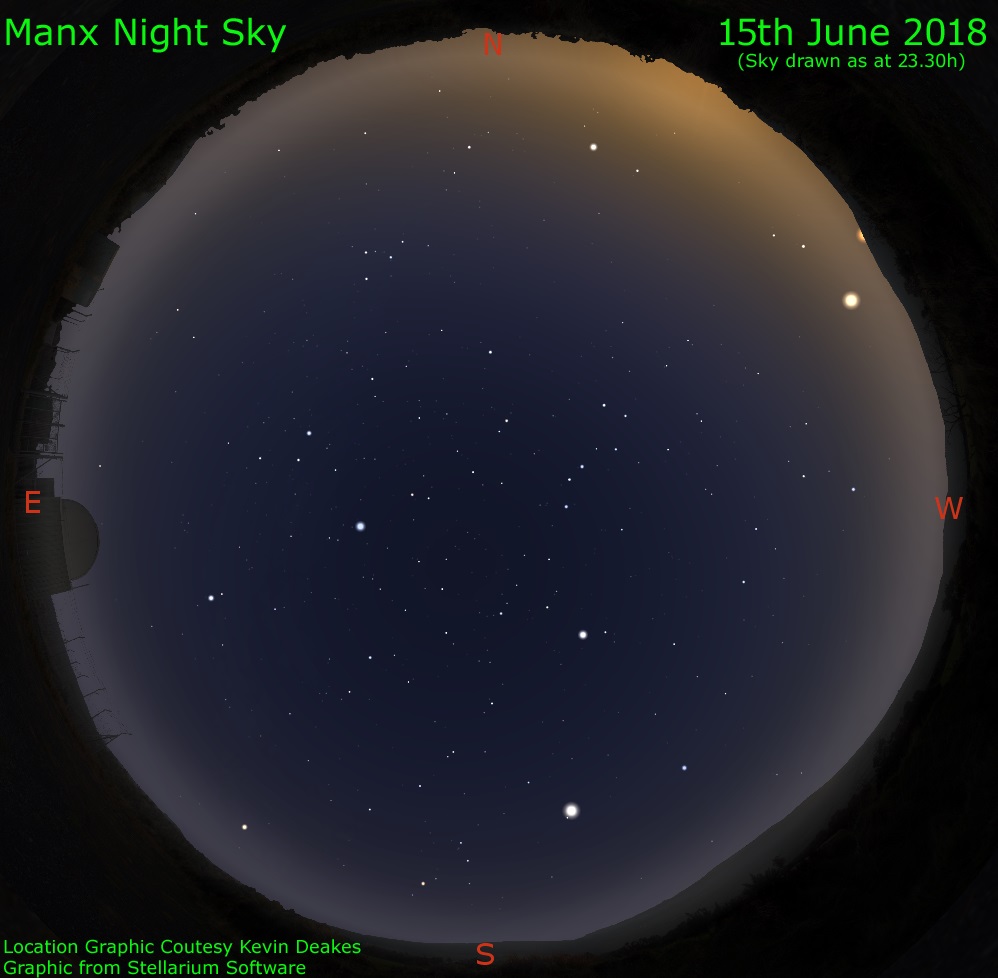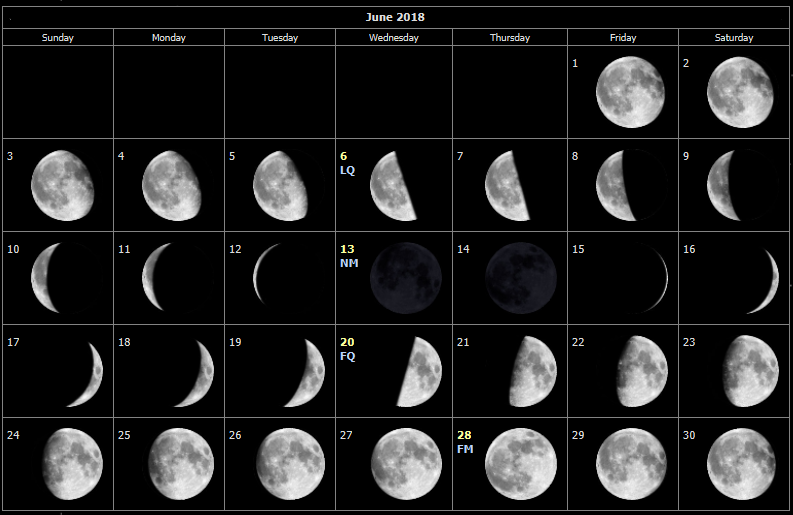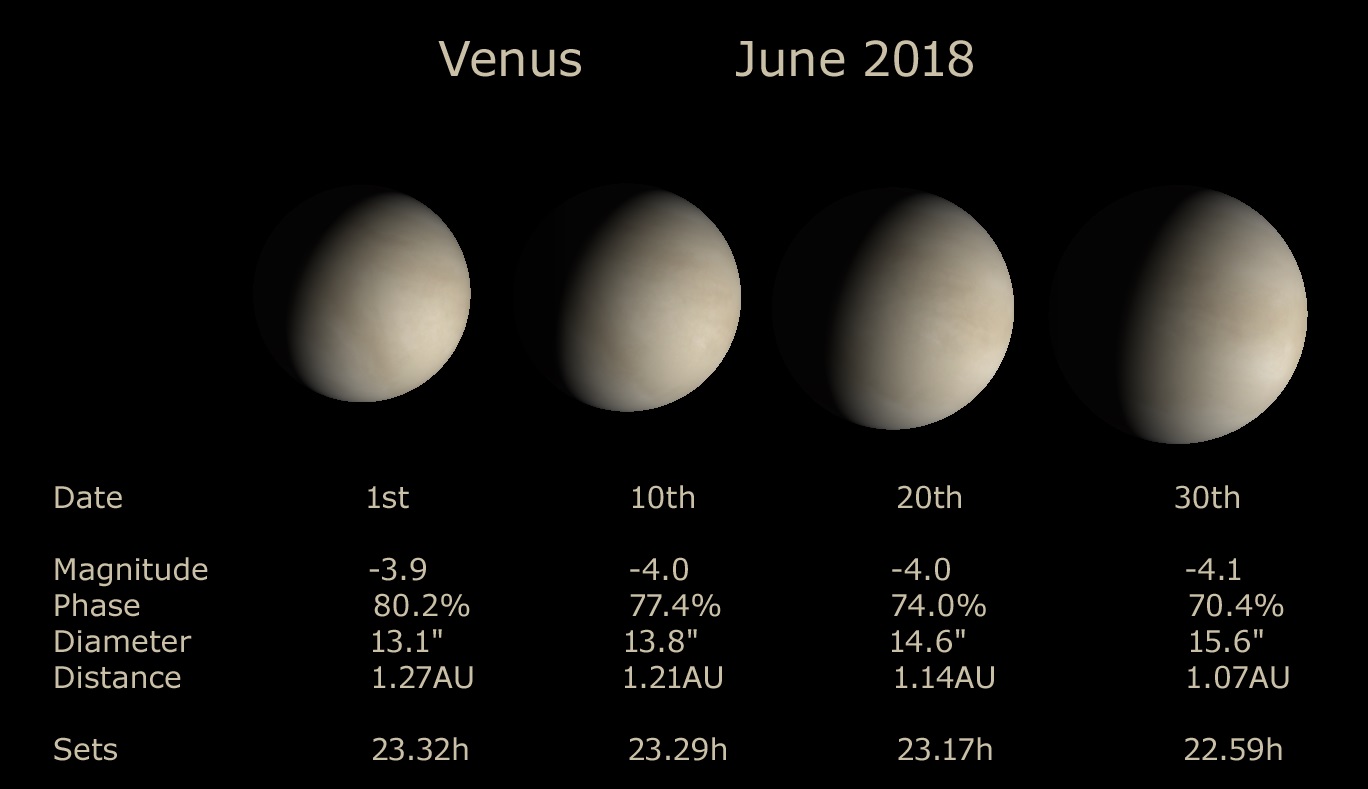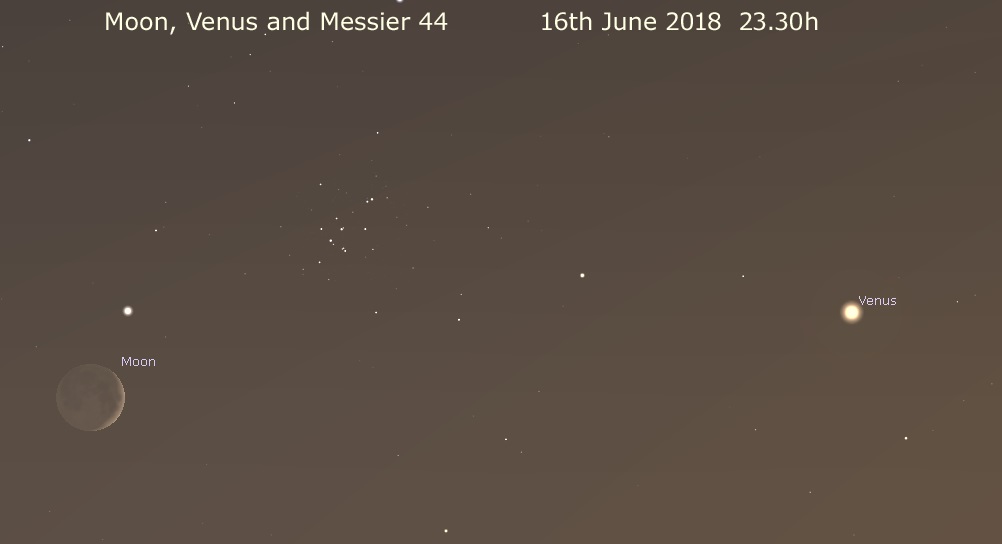In Manx skies... June 2018 ~ compiled by Dave Storey
New
13th
at
19.44h
First Quarter
20th
at
10.52h
Full
28th
at
04.54h
Last Quarter
6th
at
18.33h
Note: All times are
Universal Time (UT)
British Summer Time
is now in force. Remember to add 1 hour to any times quoted here
to get local IoM time.
Summer Solstice occurs 21st at 10h08m.
There are no Lunar or Solar eclipses this month.
Solar activity is low with solar cycle 24 now in force.
WARNING: NEVER DIRECTLY OBSERVE THE SUN WITH YOUR NAKED EYES AND/OR OPTICAL INSTRUMENTATION: YOU WILL BE BLINDED!
Carrington's Solar Rotation number 2205 starts on the 12th at 15h53m22s.
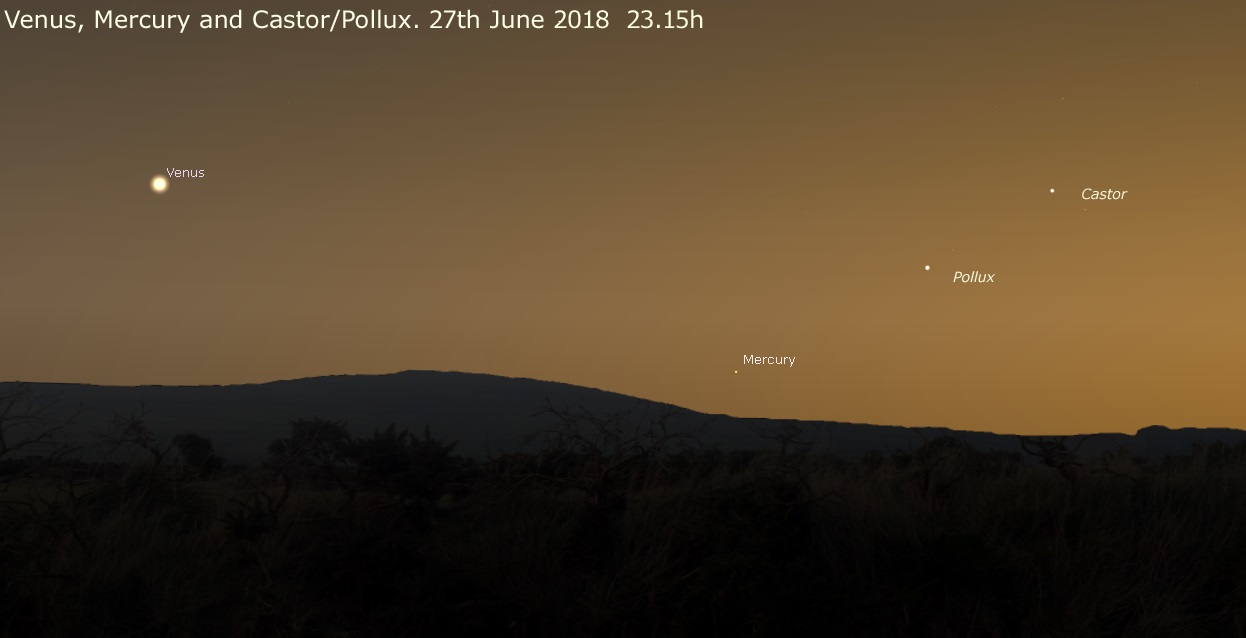
Is
at superior
conjunction on the 6th
when it passes less than 1° north of the Sun. It will
therefore not be visible during the first half of the month being
so close to the Sun. It may be possible to locate the planet in
the bright twilight sky, low down in the west using a pair of
binoculars during the second half of the month. On the evening of
the 27th,
Mercury will be in a line that joins the two bright stars of
Gemini, namely Castor and Pollux.
Will be easily visible in the western sky after sunset, shining at magnitude -3.9 to -4.1. A crescent Moon (14% illuminated) will be 6° to the left of Venus on the evening of the 16th and should be a nice view through binoculars. See the open star cluster Messier 44 upper right of the Moon on the same night. You will need to use binoculars to see the cluster due to the bright twilight sky.
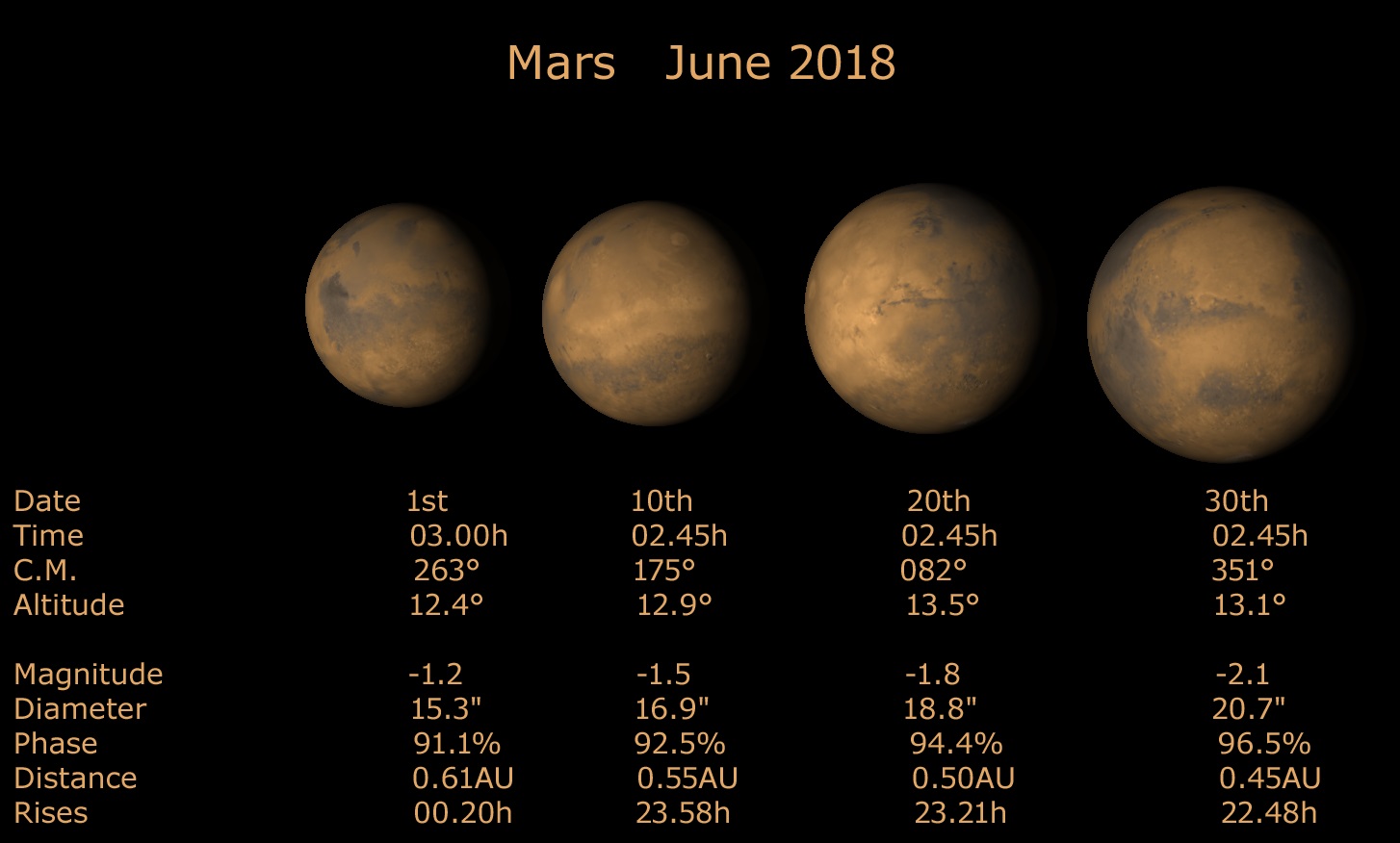
Is
in the constellation Capricornus throughout the month, shining at
magnitude
-1.2 to -2.2.
The disc of the planet as seen through a
telescope will increase in apparent diameter from 15.3 to 21.0 arc
seconds. The planet is low down in Manx skies and the image as
seen through a telescope will be somewhat degraded due to poor
seeing conditions. You may however glimpse some of the dusky
shadings on the planet.
Rises at 17.58h (in daylight)
on the 1st,
shining at magnitude
-2.5 in the constellation Libra. By the end of the month, the
planet will rise mid afternoon and will be past the meridian by
the time darkness falls.
The Great Red Spot may be seen
using a telescope in good seeing conditions. Using a light blue
filter with an eyepiece will help. Opportunities to see the Great
Red Spot from Mann occur on a regular basis.
Click here for suitable dates and
times.
As
the moons orbit Jupiter, there are occasions when the shadow of
the moons can be seen upon the surface of Jupiter and the moons
can transit across Jupiter's disc. Also, the moons can be seen to
be occulted or eclipsed by Jupiter. There are many events
throughout the month. See periodicals such as the BAA
Handbook, Astronomy Now
and Sky at Night
magazines for listings.
To help you identify the moons at any particular time, Sky and Telescope have a Java tool that will plot the moon positions. Click Here.
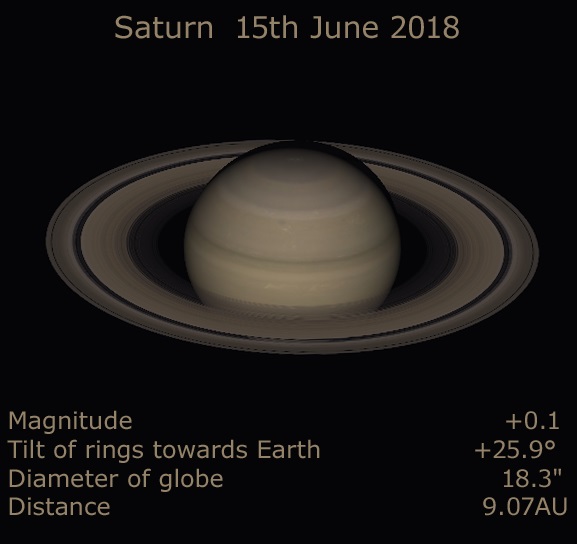 Is
at opposition
this month on the 27th
in Sagittarius. It will be shining at magnitude
-0.0
Is
at opposition
this month on the 27th
in Sagittarius. It will be shining at magnitude
-0.0
On the 28th,
the very near Full Moon is 2.8° upper right of Saturn.
The brightest moon of Saturn, Titan will be east of the planet on 13th ,14th ,15th 16th ,29th and 30th . It will be west of the planet on 6th ,7th ,8th ,22nd ,23rd and 24th . A telescope will be required to see this moon, shining at magnitude +8.5.
Ophiuchid meteors are active from May to July with two peaks of activity on the 10th and 20th this month. The shower is weak with only 5 meteors per hour at best (ZHR). Radiant for the peak on the 10th is at RA 17h56m Dec. -23° and the radiant for the 20th is at RA 17h20m Dec. -20°.
Date Time ZC# SAO# Magnitude. P.A. Type of event. Notes
24 23.23:07 2247 159466 5.4 099° DD eta
Libra
28 22.39:26 2779 187643 3.8 231° RD omicron
Sgr. D*
For
a very detailed list of occultations visible this month, click
here. (Data from Occult Software)
Times
are UT as seen from IoMAS Observatory. Start to observe these
events about 20 minutes before the above times to allow for
differences in your latitude and longitude. This will give you
time to locate the star that is about to be occulted.
ZC
= Zodiacal Catalogue. Type of Event DD = disappearance at dark
limb, RD = Reappearance at dark limb. RB = Reappearance on bright
limb. PA = Position Angle around limb of the Moon, where 0 degrees
is north, 90 degrees is east, 180 degrees is south and 270 degrees
is west.
D* = Double Star M*=Multiple Star
The above
predictions were calculated from Occult software by David Herald.
More information regarding this software may be found at the
lunar-occultations.com
web site.

June
is a month where noctilucent clouds may be seen in the northern
skies. They appear as glowing electric blue clouds in the middle
of the night and some displays can be vary bright. These clouds
are at very high altitudes, around 80 km high and it is this high
altitude that makes them glow with sunlight illuminating them from
below the northern horizon. On the Spaceweather.com
web site, there is a graphic showing showing latest observations
from AIM
satellite, sent up to investigate these mysterious clouds.
This star drops from magnitude +2.1 to +3.4 in about 5 hours. There are no suitable dates for observing this month. Click here for a star chart for Algol.
Comet
There are no predicted bright comets this month.
The international Space Station crosses the Manx skies on a regular basis. For the latest information on when the ISS is due to pass across the sky over the next ten days, visit the link below.
Bibliography for Manx Night Skies
The
Handbook of the British Astronomical Association 2018. BAA.
2017
2018 Stargazing. Heather Couper & Nigel Henbest.
Philip's 2017
2018 Guide to the Night Sky. Storm Dunlop &
Wil Tirion. Collins 2017
Yearbook of Astronomy 2018. Brian
Jones/Richard Pearson. Pen & Sword White Owl. 2017
Observer's
Handbook Meteors. Neil Bone. Philip's 1993
Atlas of the Night
Sky. Storm Dunlop. Collins. 2005
Constellations. Josef Klepešta
and Antonin Rükl. Hamlyn. 1979
Brilliant Stars. Patrick
Moore. The Book People Ltd. 1996
Complete Guide to Stargazing.
Robin Scagell. Phillip's. 2006
Turn Left at Orion. Guy
Consolmango and Dan M. Davis. Cambridge U.P. 2008
Norton's
2000.0 Edited Ian Ridpath. Longman Scientific & Technical.
1989
Planetary data derived from
Guide 9
Software.
Picture graphics derived from Stellarium
and Guide 9 Software.
